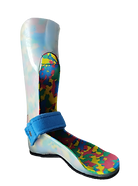


Guide to AFO Brace Selection
AFO brace selection guide to help patients/parents determine their child gait pattern and match their need for available braces.

.png)
.jpg)
Solid AFO
-
Knees, and sometimes hips, remain flexed when standing or walking
-
Posture may be due to weakness or low muscle tone


Ground Reaction AFO
-
Significant excess dorsiflexion and knee flexion: 15° or more
-
Occurs constantly (100% of the time)
-
Cannot correct when prompted
-
Can be manually corrected with strong resistance or cannot be corrected
-
Marked excess dorsiflexion and knee flexion: 5–15°
-
Occurs frequently (more than 50% of the time)
-
Can improve when prompted
-
Can be manually corrected with mild/moderate resistance
EXCESSIVE DORSIFLEXION/CROUCHING


.jpg)
Dynamic AFO
Pronation:
-
Foot collapses and medial arch flattens
-
Heel everted and forefoot abducted
Supination:
-
Weight bear on lateral side of the foot, high medial arch
-
Heel inverted and forefoot adducted

High Cut Shoe
-
Absent medial arch
-
Strong heel eversion and forefoot abduction
-
Cannot correct when prompted
-
Can be manually corrected with strong resistance or cannot be corrected
-
Visible/reduced medial arch
-
Mild/moderate heel eversion and forefoot abduction
-
Can improve when prompted
-
Can be manually corrected with Mild/moderate resistance
HIGH TONE PRONATION OR SUPINATION



SMO

.jpg)
Insole

-
Foot collapses and medial arch flattens
-
Heel everted
-
Forefoot abducted
-
Low muscle tone allows for easy correction


SMO
-
Absent medial arch
-
Strong heel eversion and forefoot abduction
-
Cannot improve when prompted
-
Can be manually corrected with moderate resistance
-
Visible/reduced medial arch
-
Mild/moderate heel eversion and forefoot abduction
-
Can improve when prompted
-
Can be manually corrected with mild resistance
LOW TONE PRONATION
UCBL insole


.jpg)
Leafspring AFO
-
Bears weight primarily on forefoot
-
Toes point downward and heel does not touch ground when walking
-
Excess muscle tone, range of motion, or habit results in toe walking
.png)

Solid AFO
-
Ankle plantarflexion: 2° or more
-
Occurs constantly (100% of the time)
-
Cannot correct when prompted
-
Can be manually corrected with strong resistance or cannot be corrected
-
Ankle plantarflexion: 0–2°
-
Occurs frequently (more than 50% of the time)
-
Can improve when prompted
-
Can be manually corrected with moderate resistance
EXCESSIVE PLANTARFLEXION/TIP TOEING


Hinge AFO

.jpg)
SOLID AFO
-
Foot and ankle positions are uncomfortable and limit function
-
Poor positions created by excess and unbalanced muscle tension
-
To accommodate the ankle and foot deformity

-
Accompanied by strong pronation/supination
-
Assisted transfers only; or non-weight-bearing
-
Cannot be manually corrected
-
Accompanied by moderate pronation/supination
-
Occasional assisted ambulation
-
Can be manually improved
POSITIONING/LIMITED AMBULATION


.jpg)
Solid AFO with Heel Raise
-
Knee locks backwards into extension
-
Excess muscle tone or weakness create knee hyperextension

-
Significant knee hyperextension: 5° or more
-
Occurs constantly (100% of the time)
-
Cannot correct when prompted
-
Can be manually corrected with strong resistance
-
Marked knee hyperextension: 2–5°
-
Occurs frequently (more than 50% of the time)
-
Can improve when prompted
-
Can be manually corrected with moderate resistance
KNEE HYPEREXTENSION

Hinge AFO with Heel Raise
_edited_edi.png)

Insole with Heel Raise